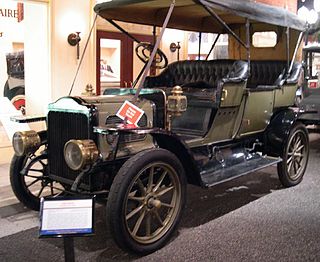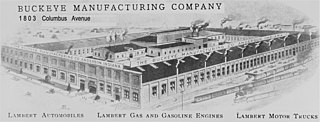
The Acme was a make of American automobiles made in Reading, Pennsylvania from 1903 to 1911. They were the successor of the Reber which was made from 1902 to 1903 by Reber Manufacturing.

L'Aster, Aster, Ateliers de Construction Mecanique l'Aster, was a French manufacturer of automobiles and the leading supplier of engines to other manufacturers from the late 1890s until circa 1910/12. Although primarily known as an engine mass manufacturer the company also produced chassis for coach-works and a complete range of components.

A steam car is a car (automobile) propelled by a steam engine. A steam engine is an external combustion engine (ECE) in which the fuel is combusted outside of the engine, unlike an internal combustion engine (ICE) in which fuel is combusted inside the engine. ECEs have a lower thermal efficiency, but carbon monoxide production is more readily regulated.

The Swift Motor Company made Swift Cars in Coventry, England from 1900 until 1931. It grew progressively from James Starley's Coventry Sewing Machine Company, via bicycle and motorised cycle manufacture. The cars ranged from a single-cylinder car in 1900 using an MMC engine, through a Swift-engined twin-cylinder 7-horsepower light car in 1904, and a 3-litre model in 1913. After the First World War a successful range was sold during the 1920s, but the Cadet of 1930 was its last vehicle as it could not compete economically with volume manufacturers such as Ford and Morris Motors.
The Daimler Manufacturing Company (DMFG), was a boutique American automaker company from 1898 to 1907. From 1888 to 1898, the company was known as the Daimler Motor Company (DMC), formed under a partnership between Gottlieb Daimler of Daimler-Motoren-Gesellschaft and William Steinway of piano manufacturer Steinway & Sons. Headquartered in Long Island City, Queens, New York City near Steinway's Astoria headquarters, the company sold Daimler motors for yachts and launches, and goods vehicles including buses and trucks. It built and sold a single automobile model, the original American Mercedes.

Alexander Winton was a Scottish-American bicycle, automobile and diesel engine designer and inventor. He also was an early automobile racer.
Rex, Rex Motorcycles, Rex-Acme, was a car and motorcycle company which began in Birmingham, England in 1900. Rex soon merged with a Coventry maker of bicycles and cars named Allard and then later in 1922 the company merged with Coventry's 'Acme' motorcycle company forming 'Rex Acme'. The company existed until 1933, and, in its heyday, was considered one of the greatest names in the British motorcycle industry.

John William Lambert was an American automobile manufacturer pioneer and inventor. He is the inventor of the first practical American gasoline automobile. He operated large manufacturing companies that made transmissions, stationary gas engines, farm tractors, commercial motor trucks, railroad inspection vehicles, and various gasoline driven street cars. He had over 600 patents. In 1891, he built a working gasoline automobile, one year before the Duryea Brothers constructed theirs.

The Union automobile was a vehicle manufactured by the Union Automobile Company from 1902 until 1905. It was designed by John William Lambert, who had developed the three-wheel Buckeye gasoline buggy in 1891. Over the next decade, Lambert substantially refined the vehicle, with modifications including an additional wheel, a more powerful engine, and a new transmission system. The Union Automobile Company was formed as a subsidiary of Lambert's Buckeye Manufacturing Company solely to manufacture the Union, which took its name from Union City, Indiana, the city where it was built and which endorsed its production. In total, the company built over three hundred Union automobiles, before development shifted to the Lambert automobile, the Union's successor.

The Lambert Automobile Company developed as a 300,000-square-foot (28,000 m2) automobile factory in Anderson, Indiana. It manufactured the Lambert automobile, truck, fire engine and farm tractor as a part of the governing Buckeye Manufacturing Company. Lambert manufactured vehicles from 1905 to 1915. In 1910 the company had over a thousand employees, and from 1910 to 1915 the production had reached about three thousand vehicles per year. It went out of business in 1917 because of World War I.

The Gladiator Cycle Company, Clément-Gladiator, was a French manufacturer of bicycles, motorcycles and cars based in Le Pré-Saint-Gervais, Seine.

Gilbert Car Company was a railroad car builder based in Troy, New York. It began manufacturing streetcars in the late 1880s. Gilbert cars were sold and exported worldwide.

The Buckeye Manufacturing Company was a company founded in 1884 by John William Lambert and his family members originally to manufacture horse drawn buggy parts in Union City, Ohio. The enterprise started with $2,000 and six men and some helper boys. The company got involved in making tools and one early horseless carriage automobile.

The Buckeye gasoline buggy, also known as the Lambert gasoline buggy, was an 1891 gasoline automobile, the first made in the United States. It was also the first automobile made available for sale in the United States. It was initially a three wheel horseless carriage, propelled by an internal combustion gasoline engine; it was later developed into a four-wheel automobile with a gearless transmission, and mass-produced during the first part of the twentieth century. The platform was later expanded into a line of trucks and fire engines.

The Union Automobile Company was an automobile factory to manufacture the Union automobile through the Buckeye Manufacturing Company. It began manufacturing automobiles in 1902 and produced them through 1905. The company was located in Union City, Indiana. The inventor of Union automobile gasoline engine and friction drive gearless transmission was John W. Lambert. In the early part of 1905 the company moved to Anderson, Indiana. It had produced 325 automobiles before going out of business in the later part of 1905. It was replaced with a redesigned model that became the Lambert automobile.
SGV was a United States automobile manufacturer that made automobiles using Lancia components.

William Morrison was a Scottish chemist. His background in chemistry piqued his interest in improving storage batteries. He concentrated on how to produce the most available energy for a unit of weight for efficiency in the working of an individual battery cell. Eventually, he developed storage batteries far more powerful than what had then been available. To demonstrate his batteries, Morrison installed 24 of them on a common horse-drawn carriage and attached an electric motor to the rear axle to be powered by them. Through various innovations, he developed the controls for the power used and the vehicle's steering so that the driver had complete control. Morrison invented the first practical self-powered four-wheeled electric carriage in the United States. His electric vehicle was the first to be driven in Chicago and in his hometown of Des Moines, Iowa. This electric horseless buggy of the late 19th century helped pave the way for the hybrid electric automobile of the 21st century.

















